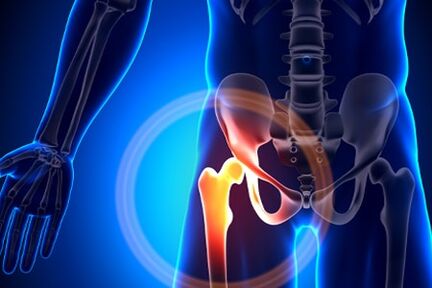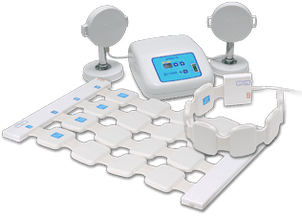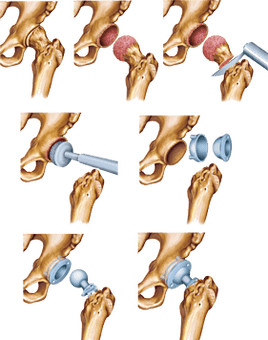
What is this disease with such an intricate name - Coksartrosis?.. This disease is a deforming arthrosis of the hip joint and is often also called osteoarthritis of the hip joint.Currently, Coksartrosis is a leader between the diseases of the musculoskeletal system, which is of a degenerative dyeing nature.There are many reasons for the occurrence of Coxarthrosiss disease and, in this regard, this disorder has become widespread in all age groups.
Coksartrosis belongs to Arthroposisi that do not have an inflammatory nature, in which initially there are changes in a degenerative dyeing nature in the cartilage of the hip joint, which connects the surfaces of the joint bones and in the subsequent stages there are already bone changes directly.During a course so gradually being developed by Coxartrosis, there is a violation of the naturally normal functions of the articulated articulation of the affected hip, which, ultimately, leads to a violation of the functions of the musculoskeletal system of a sick person, in general.
For the most part, the arthrosis of the hip joint is suffered by people over the age of forty.Of course, Coxartrosis, like other diseases, seems to be able to successfully treat without surgery, but only in its early stages.But in its subsequent stages, it is unlikely that it will be possible to do without surgery and only one thing can help to avoid disability: prostheses of the articular coxartrosis of the joint.Unfortunately, sick people, without attacking small pains in the hip joint in the initial phase of the disease, avoid looking for a doctor and the arthrosis of the hip joint, in the meantime, continue to progress the day after the day, gradually transforming themselves into a more neglected form.

How Coksartrosis develops
Let's take a look at the developmental development mechanism of the disease.And let's start with the fact that the hip joint is made up of two bones:
- the end of the more femur, similar to a ball;
- the swivel, similar to a small lush billiards located in the iliac part of the pelvis;
- A special joint cartilage on the surface of both bones, which recalls a substance as a sponge and necessary as a shock absorber, which is compressed during the movement and straightens in its absence;
- As well as the ligaments that form the cavity itself of the hip joint and therefore form the joint capsule.
In addition, there is muscle tissue, somehow femoral, buttero and other muscles, on whose functionality also depends on the state of the hip joint.
During the movement, when compressing the joint cartilage, a specific fluid is "crushed" in the articulation, which is a kind of lubricant for the bones that are articulated in the joint.In addition, the same joint cartilage performs the function of the uniform distribution of loads on the surface of the joint, being an excellent shock absorber during the movements.
The occurrence of Coxarthrosiss is mainly due to the fact that the power of the cartilage of the hip joint is disturbed.The cartilage becomes thinner and then disappears in some places.If measures are not adopted to stop this process, then in those places where the cartoon of the cartilage described above occurs, the bone itself will grow directly, thus trying to "fill" the void of the joint cavity with itself.As a result of these bone changes, therefore osteophytes begin to appear, that is, "peaks" on the bones.These deformations, in turn, lead to a violation of the congruence of the bones which are articulated in the hip joint and the subsequent "abrasion" of the still healthy sections of the joint cartilage.
The causes of arthrosis of the hip joint
The causes of coxartrosis with which it presents can be divided into primary, with unclear and secondary etiology, following other diseases, for example, such as: for example:
- Dislocation of the thigh, which is innate;
- femoral dysplasia;
- Aseptic necrosis of the femoral head itself;
- Previously transferred various injuries, such a fracture of the neck of the thigh;
- Disease pearls;
- inflammatory processes in the hip joint;
Since Coxartrosis disease is found not only for one, but at the same time both the hip joints, it is completely possible to say that bilateral coksartrosis is a rarity.Although with primary coxartrosis, the knee joint or spine is often affected.
Symptoms of coxartrosis
The first symptoms of coxartrosis depend directly on the degree of damage to the hip joint, as well as the development stage of this disease, and the main ones are:
- The pain manifested during the movement, in the hip joint and disappearing at rest;
- arise lame;
- rigidity that appeared in the hip joint;
- downward progress of the amplitude of the hip movements;
- The weakness of the femoral muscles and a remarkable decrease in their volume.
Separately, we consider the symptoms of coxartrosis depending on the degree of the disease with this disorder:
- Symptoms of the 1st degree of Coxartrosis: in the hip joint there are pains that are moderate and only after the articulation has been subjected to intensive dependent for a long time.After removing the load and rest, this syndrome is completely stopped.At the first degree, the symptoms of coksartrosis of the pace remain ordinary and the volume of joint movements does not change.
- Symptoms of the 2nd degree of Coxartrosis: the pain in the hip joint is felt more intense than in the first degree, but they are also projected in the inguinal region.Due to development muscle at developing, the knee begins to get sick and the knee and often strongly strongly.Sometimes, with the symptoms of cokesartrosis of the second degree, the pain begins to appear at rest and, after the load on the articulation concerned, a rather long rest is already necessary to stop it.Close begins to appear when you run or walk for a long time.At the same time, the force of the hip muscles is rather reduced and the volume of joint movements is also underestimated.
- Symptoms of the 3rd degree of Coxartrosis: a pain syndrome constantly pronounced in the hip joint, not passing even after an extremely long or constant rest at rest, even at night.The pain has already been completely influenced by the entire leg.Against the background of pain, the sick man develops insomnia and various sleep disorders.There is a strong atrophy of the thigh muscles, buttocks and lower legs, while the volume of the engine of the joint is almost minimal.When walking, a sick person to move is forced to resort to auxiliary means, such as a stick.
If this arthrosis of the hip joint develops only in the hip joint of one leg, its weakened femoral muscles give a momentum to the development of the lateral movement of the pelvis, due to the decrease in the length of the leg with the joints affected by coxartrosis.
Coksartrosis diagnosis
When the diagnosis of coxarthrosis are conducted, the symptoms of coxartrosis are taken into consideration, described above, in combination with the data obtained of an X -ray examination of the patient.This technique offers the possibility of determining not only the very degree of coxartrosis, but to identify the causes that are served by a catalyst for the development of coxartrosis.The X -ray offers an excellent opportunity to determine the changes that led specifically to injuries in the hip joint area, which is directly related to the mechanisms of the development of coxarthrosis.
In addition to the already listed diagnosis methods, it is also possible to use computerized tomography methods and magnetorononance imaging, providing the possibility of a detailed detailed study of the developing pathology, such as, for example, bone tissue, whose deformation is a satellite of this disorder.As for magnetic resonance imaging, this method still allows the evaluation of the pathological disorders to which the soft tissues that surround the joints affected by coxarthosis have been subjected.

Treatment of arthrosis of the hip joint
The choice of treatment for Coksartrosis depends directly on the symptoms of this disease and its stadium.Typically, the first and second degree of arthrosis of the hip joint, a traditional-conservative drug therapy is performed, consisting of an intake of chondroprotectors, vasodilated drugs and, according to indications, also muscle relaxants.In the period in which Coxartrosis is particularly acute, non -pounded anti -inflammatory drugs are not used.It should be borne in mind that such treatment must be carried out by a specialist, since the self-media of the drug, unlike traditional medicine, can have an extremely negative effect on the patient's internal organs and completely suppress the ability to restore the Ialine cartilage.
In addition, with the arthrosis of the hip joint, various physiotherapy and operating therapy procedures are prescribed.
Particularly effective, combined with the traditional pharmacological treatment of arthrosis of the hip joint, is the use of the magnetotherapy method.The magnetotherapy method in the early stages is particularly effective: it avoids dystrophic changes and rotates the disease back.In the subsequent stages, the method increases performance and quality of life, reduces the risk of complications in the articulation concerned.
The impact on the patient's body with Coxarshrosis does not have a directly therapeutic effect with a diet, but has recommended obese people to reduce body weight, since it allows to reduce the load on the articulation concerned, thus facilitating the acute symptoms of coxarthrosis.

As regards the third degree of coxartrosis, whose symptoms are more painful, the treatment, as such, is performed only through surgery, for example, a hip articulation ending is performed.
Endoprothesis includes components that are functional analogues of the hip joint.This orthopedic product is installed inside the limb, which is determined by its name (Endo - by the Greek "interior").An artificial substitute for the articulation of the hip performs a musculoskeletal function, but unlike the natural joint in it, the lubricating fluid does not occur.Yes, it is not necessary, since this prosthesis is made with materials that, without lubrication, slide easily and do not destroy.
The statistical data indicate that after surgery, the absolute restoration of the functions of the limbs with the deformation of arthrosis of the hip joint is obtained in 95% of cases, which allows you to subsequently lead a rather active lifestyle.
The life of this prosthesis is about 15 ... 20 years, but at the end of its service a second operation is needed to replace a worn endoprotesis.
note thatIt's important!Do not diagnose yourself!In the case of symptoms of coxartrosis, it is necessary to consult a orthopedic doctor, since only a qualified specialist can make a correct diagnosis and prescribe the more optimal treatment.
Coxartrosis prevention
Coxartrosis disease can also be avoided if the necessary prevention of Coksartrosis is performed:
- Mandatory and timely treatment of inflammatory joint diseases;
- timely treatment of joint dysplasia;
- Correct physical activity and mandatory reasonable, in particular exercises with weights that should be performed correctly;
- Mandatory control of the weight of your body, with its maintenance normally;
- The prevention of joint lesions.



















